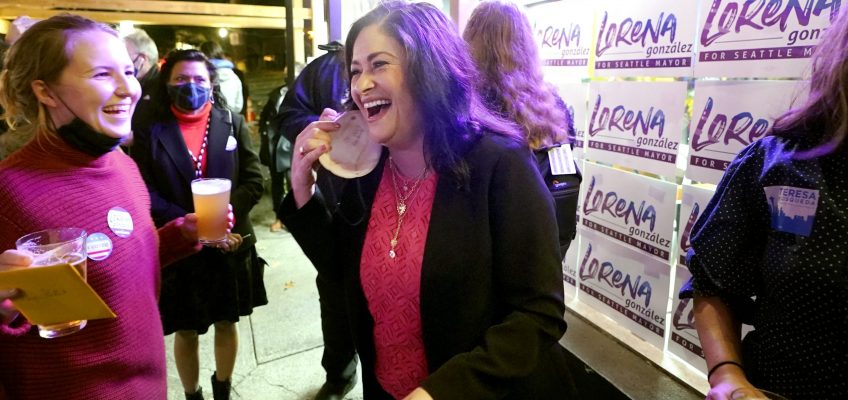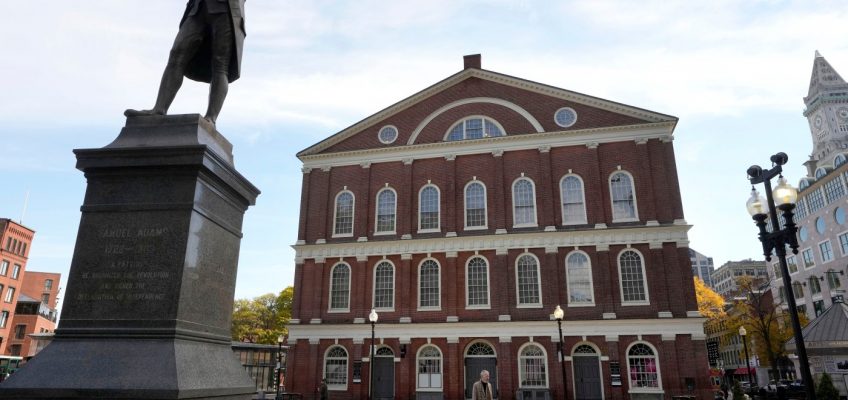SACRAMENTO, Calif. — The leader of the influential California Labor Federation rocked Sacramento’s political establishment last fall when she suggested a blacklist for consultants who run afoul of unions.
Lorena Gonzalez, a progressive powerhouse who had stepped down as a state lawmaker to head the venerated Labor Federation AFL-CIO, argued consultants can’t get paid to bust unions and take on fights against workers and then expect to benefit from members’ money. And her stance won praise from some allies in labor.
So it was a head-snapping development inside several of the unions when Gonzalez quietly tapped her own longtime political strategist, one-time Willie Brown fixer Richie Ross, to formally consult for the Labor Federation. Ross had helped some of the state’s biggest corporate employers defeat a generational union-backed push in 2020 to raise property taxes on big businesses, which would have sent billions a year to schools and local governments.
In the weeks and months since he joined the Labor Federation, no fewer than eight high-level people directly connected to the group and broader labor world aired their discomfort and frustration with the arrangement to POLITICO. Several contend Gonzalez’s decision to hire Ross smacked of hypocrisy, arguing his past work makes him a poster boy for any boycott members had contemplated.
“She has put on the Labor Federation’s payroll a guy who has worked against the Labor Federation — just because she wants him there,” said a high-ranking labor official in Sacramento, who was granted anonymity to discuss a sensitive topic. “And she’s doing this as she’s vilifying everybody else in town about their lack of purity.”
Gonzalez said in an interview that the Labor Federation has a formal process for placing consultants on its so-called “Do Not Patronize” list. If any of the unions want to put Ross on the list, she said, they can propose to do so.
“No one has done so,” Gonzalez added. She declined further comment.
Ross offered a three-word quote, in Spanish, to express how little the backlash mattered to him.
“No me importa,” he said.
Anxiety over Ross’ hire represents an exceedingly rare public eruption among California’s guarded labor unions. Disputes over personnel and strategy are often closely held, and several union leaders and advisers described their decision to speak out as a last resort to convey their exasperation — albeit mostly anonymously. Their moves also hint at broader tensions among leadership, and with Gonzalez, as unions collectively flex their political muscle amid another banner year in California’s Democratic-controlled statehouse.
Balding and bespectacled, Ross is the quintessential Sacramento throwback, patrolling the marble halls of the Capitol to coax, cajole and outright bully staffers and lawmakers alike into supporting his favored bills. With his unusual dual roles as lobbyist and political consultant, sometimes the legislators he is trying to influence are his own clients.
His deep institutional knowledge has yielded results for labor clients, like winning health care coverage for members of the United Farm Workers. Among his other union ties are the Los Angeles County Federation of Labor, AFSCME, UNITE HERE, California Nurses, and several union-oriented lawmakers.
But he’s also helped lead campaigns that were on the opposite side of labor’s biggest and most expensive priorities. And his firm has lobbied against legislation supported by unions.
Ross has spent decades working on behalf of the oil industry — a divisive force in labor regarded by certain trade unions and more conservative members as a crucial partner in creating jobs but viewed by progressives and some public sector workers as out of step with their values. In 2020, the year Ross worked on the successful campaign to fight commercial real estate tax hikes in Proposition 15, he also helped to block an initiative to end cash bail, another union priority.
In both cases, Ross was taking on two labor powerhouses: Service Employees International Union and the California Teachers Association. CTA’s Issues PAC and SEIU State Council spent a combined $25.3 million in support of Proposition 15, which received another roughly $5.3 million from SEIU Local 2015 and SEIU 1021. The measure also was backed by AFSCME, UNITE HERE and the California Federation of Teachers.
“CFT has been on the opposite [side] of Richie’s firm a few times on some very primary issues of CFT’s — teacher due process and Prop. 15,” Jeffery Freitas, president of the California Federation of Teachers, said in an interview.
“Under my leadership,” Freitas added, “CFT will never hire Richie Ross.”
SEIU spent another $500,000 on the failed bail reform effort.
Another top leader in the Labor Federation summed up Ross’ involvement in the organization as akin to inviting a stranger with mixed financial motives to a seat at the table.
“Richie has experience and knows the business. He has great relationships. He’s smart. He’s strategic. He’s thoughtful. So he’s not a bad person to have on your team,” the labor leader said. “But you can’t trust somebody on your team if they’re also playing with the other side.”
Concerns over Ross coming aboard the Labor Federation had been bubbling up for months earlier this year. On June 9, the secretary of state’s filings first listed him as a lobbyist to the sprawling labor organization where Gonzalez is executive secretary-treasurer. Filings through June 30, the latest available, show Ross was paid $2,000 for the three-week period.
By the time Ross officially came on board, Gonzalez had already publicly put Democratic consultants on notice: Work for companies that run counter to organized labor’s goals could land them on a union blacklist. That she was reviewing procedures to kickstart the process as head of the influential labor organization made up of some 1,300 unions and millions of members across manufacturing, retail, construction, health care and other industries grabbed the attention of Sacramento insiders.
Recent chatter about a union blacklist reached a fever pitch after Gonzalez came into her new role in 2022. Gonzalez reiterated her point when her organization defended Assembly candidate and Alameda labor leader Liz Ortega-Toro against campaign tactics by housing industry groups. “Strong women of color are too often the targets of this type of ugly politics,” Gonzalez said at the time.
The Labor Federation news release added that those who violate the basic values upheld by the labor movement will be held accountable by any means necessary, including being placed on a “Do Not Patronize” list.
“You can’t get paid to union bust or take on fights against workers and ALL of labor & expect to turn around and benefit from our members’ money,” Gonzalez wrote on social media weeks earlier. Despite the warning, the federation has not formally blacklisted anyone under her leadership and has received no formal proposals to do so.
“Do not hire” lists sit squarely at the intersection where ideological fissures and the lucrative business of politics collide. After a string of upstarts ousted congressional incumbents in the 2018 cycle, the House Democrats’ campaign arm refused to work with any vendor that had contracted with the challengers. The committee backed away from its policy after less than two years amid backlash from the party’s progressive wing.
Similar blacklists have cropped up sporadically in California. In one widely-publicized 2013 spat, the Labor Federation announced it was placing six consultants on a “Do Not Hire” list for their work for two Democrats who successfully beat Assembly incumbents from their party. Among them was now-state Sen. Steve Glazer, who managed former Gov. Jerry Brown’s 2010 campaign and worked the following cycle with the Chamber of Commerce.
That blacklist, along with others enforced during recent state campaigns, ultimately fizzled out, as consultants petitioned to get back into labor’s good graces, or at least out of its proverbial doghouse. Still, the tactic has been a well-worn tool to send a message for those who deviate from the party line.
Glazer said the practice of compiling such lists is “a form of righteousness.”
“We’ve seen a demand for purity rip apart the Republicans in Congress and we continue to see it with those that underpin the Democrats’ supermajority in California,” Glazer said. “Any movement that excludes people who don’t always agree with them risks losing the broad support they need to succeed. ”
Gonzalez has been quick to register disgust when members of her party take on clients she feels undermine the workers’ cause. When the American Prospect magazine reported in August that Minyon Moore, chair of the Democratic National Convention, is a principal at a firm that did work for labor nemeses such as Lyft and Tenet Healthcare, Gonzalez reposted the article on X, formerly known as Twitter.
“This is gross,” she wrote.
Her post was later deleted, but not before it caught the eye of some California Democrats. Moore is one of the most influential Black women in the party, and it did not sit well with some observers that Gonzalez was swiping at a woman of color for the provenance of her paycheck — particularly when Ross, her political consultant, didn’t engender the same public disapproval.
A third labor official focused on the Moore tweet, saying it gave the appearance that, “If you’re a white guy, the same criticisms don’t apply than if you’re a person of color,” the official said. “And that was the dangerous part about putting that message out there.”
To Gonzalez’s detractors, the tweet about Moore put an exclamation point on the months of simmering discontent about her hiring of Ross.




